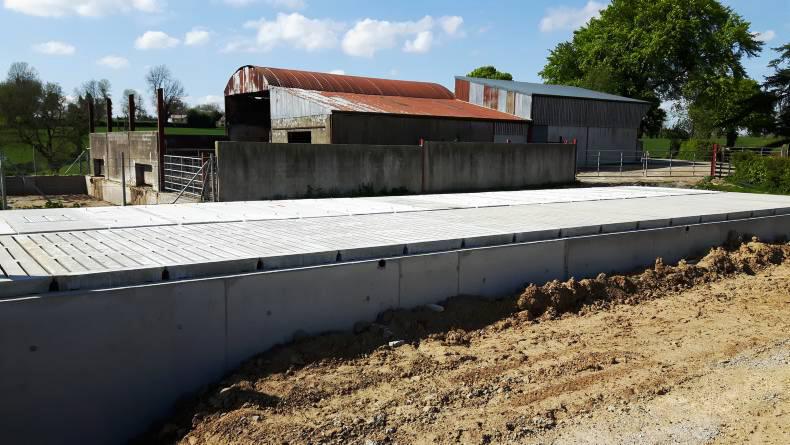Over the next three weeks, the Irish Farmers Journal will be investigating the main slurry storage options available to farmers. The second Targeted Agricultural Modernisation Scheme (TAMS II) provides grant aid for three different types of slurry storage units, including concrete slurry tanks, geomembrane-lined slurry stores (lagoons) and over-ground circular slurry stores (slurry towers).
Many farmers who are planning on expanding stock numbers will be considering which slurry storage option is the best for them. Each has its merits and demerits.
The most suitable option for a farm comes down to farm finances, the type of site and planning for the future. In this first instalment of our three-week series, we look at concrete slurry tanks.
Some farmers prefer to install a concrete tank because they feel it is the most durable option – there is the possibility of building animal housing above the tank in the future and some county councils prefer to give planning permission for concrete tanks rather than lagoons.
However, on the other hand, not every site is suitable for constructing a concrete slurry tank. The cost of building a concrete tank can also be enough to prevent farmers choosing this option too.
Advantages of concrete tanks
Disadvantages of concrete tanks
Concrete slurry tank example
Aidan Kelly from Agri Design and Planning Services in Newcastle, Clonmel, Co Tipperary, kindly assisted us with plans and costings for underground concrete slurry tanks.
Figure 1 shows the plans for two concrete tanks that a farmer may build for slurry storage. The top concrete tank has capacity for 16 weeks of slurry storage for 100 cows. The tank is 45m long, 4.7m wide and 2.7ft deep (9ft). It has a usable volume of 528.75m3.
The tank is designed to suit 16ft6in slats if required in the future. There are two agitation points at either end of the tank and a protective safety fence surrounding the tank is required because it is not covered.
Table 1 shows the Department reference costs for building this tank and the maximum grant aid available for a successful TAMS II application. This concrete tank would cost €39,020 excluding VAT, according to those reference costs. A safety fence to surround the tank would cost €5,196.50 excluding VAT and a circulation pipe system would cost a further €665 excluding VAT.
The 100-cow tank could be slatted at a cost of approximately €6,500 excluding VAT, which could be a viable alternative to fencing the tank.
In total, to build this size of tank, it would cost €46,389.50 excluding VAT. Under the Young Farmer Capital Investment Scheme (YFCIS) in TAMS, the maximum grant an applicant could get if building this tank would be €27,834. A non-qualifying YFCIS farmer could apply for grant aid through the Animal, Welfare, Safety and Nutrient Storage Scheme, where the maximum grant would be €18,556.
The bottom concrete tank in Figure 1 has capacity for 16 weeks of slurry for 200 cows. The tank is 45m long, 9.4m wide and 2.7m deep. It has a usable volume of 1,057m3.
This tank could be kitted out with slats supported by precast concrete pillars in the future. Table 2 shows the Department reference costs for building this tank and the maximum grant aid available for a successful TAMS II application. The tank cost €59,992 excluding VAT.
Under the Young Farmer Capital Investment Scheme in TAMS, the maximum grant an applicant could get if building this tank would be €35,954. A non-qualifying YFCIS farmer could apply for grant aid through the Animal, Welfare, Safety and Nutrient Storage Scheme, where the maximum grant would be €23,969.
Main specifications
As is the case with the majority of building work carried out through Department of Agriculture grant aid, there are minimum specifications that farmers must follow when building concrete slurry tanks. The specification for concrete tanks is listed on the Department’s website under S123.
Concrete
According to the Department, for purpose-built silage effluent tanks and channels, concrete must be purchased on the basis of a characteristic 28-day cube crushing strength of 45N/mm2 (strength class C35/45). Minimum cement content must be 360kg/m3. The maximum water to cement ratio will be 0.5. The specified slump class must be S2 or S3. Maximum aggregate size must be 20mm.
The concrete must be ordered using the appended form for ‘S.100 Mix A’ or by requesting ‘45N concrete with 360kg cement minimum, 0.50 water cement ratio maximum, and slump class S2 or S3, certified to IS EN 206, for use to Specification S.100’.
Tank floor and wall thickness
The floor slab must be not less than 225mm thick throughout. It must extend 250mm outside the walls. The concrete must be thoroughly compacted, and compaction around steel reinforcement must be carried out with a poker vibrator. The floor must be finished smooth.
Agitation points
Open external tanks must be designed with full allowance for rainfall within the tank area. The Department says external slurry tanks must have at least two well-separated agitation points.
Tank walls
Wall thickness must be 225mm minimum or 400mm minimum where tank walls are to support a super structure. Steel shuttering is recommended for tank walls, but panels with timber may be used. All shuttering must be clean and tight fitting to prevent loss of grout.
Safety tank fencing
A stock- and child-proof fence 1.8m high must be provided around all external tanks not already protected by safety covers. Posts must be 2.3m long and a minimum of one of:
a) Reinforced concrete 125mm x 125mm at butt end (to IS EN 12839:2012).
b) Galvanised angle iron 60mm x 60mm x 6mm thick.
c) Galvanised tubular steel, 75mm outside diameter, and 3.2mm thick.
Next week:
We will investigate the costs involved in building a geomembrane-lined slurry store (lagoon) for the second instalment of the slurry storage option series
